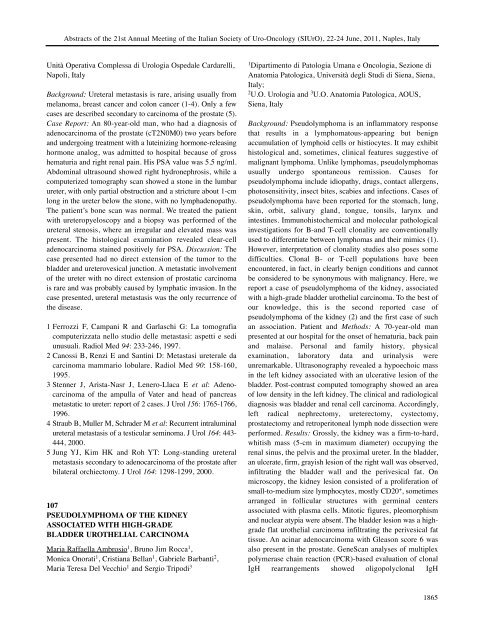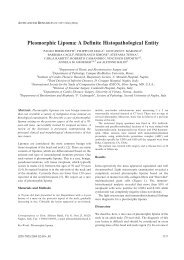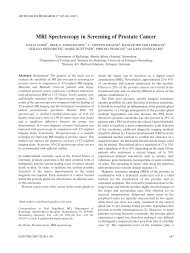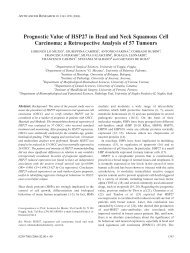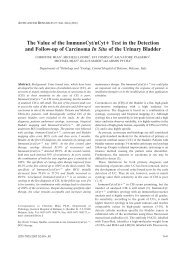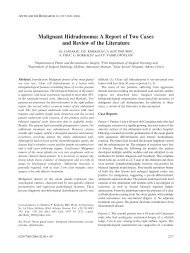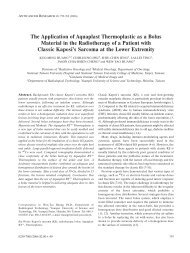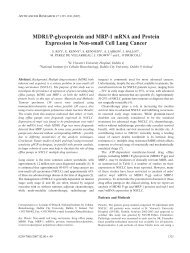ABSTRACTS OF THE 21st ANNUAL MEETING OF THE ITALIAN ...
ABSTRACTS OF THE 21st ANNUAL MEETING OF THE ITALIAN ...
ABSTRACTS OF THE 21st ANNUAL MEETING OF THE ITALIAN ...
Create successful ePaper yourself
Turn your PDF publications into a flip-book with our unique Google optimized e-Paper software.
Abstracts of the <strong>21st</strong> Annual Meeting of the Italian Society of Uro-Oncology (SIUrO), 22-24 June, 2011, Naples, Italy<br />
Unità Operativa Complessa di Urologia Ospedale Cardarelli,<br />
Napoli, Italy<br />
Background: Ureteral metastasis is rare, arising usually from<br />
melanoma, breast cancer and colon cancer (1-4). Only a few<br />
cases are described secondary to carcinoma of the prostate (5).<br />
Case Report: An 80-year-old man, who had a diagnosis of<br />
adenocarcinoma of the prostate (cT2N0M0) two years before<br />
and undergoing treatment with a luteinizing hormone-releasing<br />
hormone analog, was admitted to hospital because of gross<br />
hematuria and right renal pain. His PSA value was 5.5 ng/ml.<br />
Abdominal ultrasound showed right hydronephrosis, while a<br />
computerized tomography scan showed a stone in the lumbar<br />
ureter, with only partial obstruction and a stricture about 1-cm<br />
long in the ureter below the stone, with no lymphadenopathy.<br />
The patient’s bone scan was normal. We treated the patient<br />
with ureteropyeloscopy and a biopsy was performed of the<br />
ureteral stenosis, where an irregular and elevated mass was<br />
present. The histological examination revealed clear-cell<br />
adenocarcinoma stained positively for PSA. Discussion: The<br />
case presented had no direct extension of the tumor to the<br />
bladder and ureterovesical junction. A metastatic involvement<br />
of the ureter with no direct extension of prostatic carcinoma<br />
is rare and was probably caused by lymphatic invasion. In the<br />
case presented, ureteral metastasis was the only recurrence of<br />
the disease.<br />
1 Ferrozzi F, Campani R and Garlaschi G: La tomografia<br />
computerizzata nello studio delle metastasi: aspetti e sedi<br />
unusuali. Radiol Med 94: 233-246, 1997.<br />
2 Canossi B, Renzi E and Santini D: Metastasi ureterale da<br />
carcinoma mammario lobulare. Radiol Med 90: 158-160,<br />
1995.<br />
3 Stenner J, Arista-Nasr J, Lenero-Llaca E et al: Adenocarcinoma<br />
of the ampulla of Vater and head of pancreas<br />
metastatic to ureter: report of 2 cases. J Urol 156: 1765-1766,<br />
1996.<br />
4 Straub B, Muller M, Schrader M et al: Recurrent intraluminal<br />
ureteral metastasis of a testicular seminoma. J Urol 164: 443-<br />
444, 2000.<br />
5 Jung YJ, Kim HK and Roh YT: Long-standing ureteral<br />
metastasis secondary to adenocarcinoma of the prostate after<br />
bilateral orchiectomy. J Urol 164: 1298-1299, 2000.<br />
107<br />
PSEUDOLYMPHOMA <strong>OF</strong> <strong>THE</strong> KIDNEY<br />
ASSOCIATED WITH HIGH-GRADE<br />
BLADDER URO<strong>THE</strong>LIAL CARCINOMA<br />
Maria Raffaella Ambrosio 1 , Bruno Jim Rocca 1 ,<br />
Monica Onorati 1 , Cristiana Bellan 1 , Gabriele Barbanti 2 ,<br />
Maria Teresa Del Vecchio 1 and Sergio Tripodi 3<br />
1Dipartimento di Patologia Umana e Oncologia, Sezione di<br />
Anatomia Patologica, Università degli Studi di Siena, Siena,<br />
Italy;<br />
2U.O. Urologia and 3U.O. Anatomia Patologica, AOUS,<br />
Siena, Italy<br />
Background: Pseudolymphoma is an inflammatory response<br />
that results in a lymphomatous-appearing but benign<br />
accumulation of lymphoid cells or histiocytes. It may exhibit<br />
histological and, sometimes, clinical features suggestive of<br />
malignant lymphoma. Unlike lymphomas, pseudolymphomas<br />
usually undergo spontaneous remission. Causes for<br />
pseudolymphoma include idiopathy, drugs, contact allergens,<br />
photosensitivity, insect bites, scabies and infections. Cases of<br />
pseudolymphoma have been reported for the stomach, lung,<br />
skin, orbit, salivary gland, tongue, tonsils, larynx and<br />
intestines. Immunohistochemical and molecular pathological<br />
investigations for B-and T-cell clonality are conventionally<br />
used to differentiate between lymphomas and their mimics (1).<br />
However, interpretation of clonality studies also poses some<br />
difficulties. Clonal B- or T-cell populations have been<br />
encountered, in fact, in clearly benign conditions and cannot<br />
be considered to be synonymous with malignancy. Here, we<br />
report a case of pseudolymphoma of the kidney, associated<br />
with a high-grade bladder urothelial carcinoma. To the best of<br />
our knowledge, this is the second reported case of<br />
pseudolymphoma of the kidney (2) and the first case of such<br />
an association. Patient and Methods: A 70-year-old man<br />
presented at our hospital for the onset of hematuria, back pain<br />
and malaise. Personal and family history, physical<br />
examination, laboratory data and urinalysis were<br />
unremarkable. Ultrasonography revealed a hypoechoic mass<br />
in the left kidney associated with an ulcerative lesion of the<br />
bladder. Post-contrast computed tomography showed an area<br />
of low density in the left kidney. The clinical and radiological<br />
diagnosis was bladder and renal cell carcinoma. Accordingly,<br />
left radical nephrectomy, ureterectomy, cystectomy,<br />
prostatectomy and retroperitoneal lymph node dissection were<br />
performed. Results: Grossly, the kidney was a firm-to-hard,<br />
whitish mass (5-cm in maximum diameter) occupying the<br />
renal sinus, the pelvis and the proximal ureter. In the bladder,<br />
an ulcerate, firm, grayish lesion of the right wall was observed,<br />
infiltrating the bladder wall and the perivesical fat. On<br />
microscopy, the kidney lesion consisted of a proliferation of<br />
small-to-medium size lymphocytes, mostly CD20 + , sometimes<br />
arranged in follicular structures with germinal centers<br />
associated with plasma cells. Mitotic figures, pleomorphism<br />
and nuclear atypia were absent. The bladder lesion was a highgrade<br />
flat urothelial carcinoma infiltrating the perivesical fat<br />
tissue. An acinar adenocarcinoma with Gleason score 6 was<br />
also present in the prostate. GeneScan analyses of multiplex<br />
polymerase chain reaction (PCR)-based evaluation of clonal<br />
IgH rearrangements showed oligopolyclonal IgH<br />
1865


